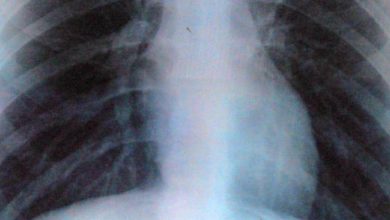From the time we are babies, we long for the touch of our mother or father. As children grow, they usually put their arms up and want to be embraced or held. I even notice that my 5-month-old daughter is beginning to reach out to grab my face, my nose or my chin. Over the past 5 months that my wife has been breastfeeding her, Lily (my daughter) has learned to grab onto my wife and it is a beautiful act to witness. Touch is one of the first senses that Lily is beginning to develop and explore, just like other infants her age.
During the preclinical years of medical school, we all begin to view touch in a different way. Through physical examination courses, we learn how to palpate an abdomen or spleen, auscultate the heart, and feel for lymph nodes. At first, laying hands on a classmate can be uncomfortable. It becomes even more nerve-wracking when you are on the wards during your 3rd and 4th years with actual patients. Both allopathic (MD) and osteopathic (DO) medical students have to learn the art of touch related to physical examination in order to graduate medical school.
I earned my Doctor of Osteopathic Medicine from Lake Erie College of Osteopathic Medicine (LECOM) Bradenton, Florida in 2008. One fundamental difference between allopathic and osteopathic medical education is the osteopathic manual manipulation (OMM, or Osteopathic Manipulative Therapy, OMT). OMM is a hands-on approach to diagnose and treat not only musculoskeletal disorders but also a plethora of other conditions such as sinus congestion, acid reflux, and methods to improve lymphatic circulation. As stated in an Osteopathic medical text, “Foundation of Osteopathic Medicine”* , DO physicians embrace the following principles: “the person is a unit composed of body, mind, and spirit” and “the body is capable of homeostasis, self-healing, and health maintenance”.
||Read: Develop Compassion Before Medical School||
Through the OMT courses during the preclinical years, we became more familiar with our classmates in an almost intimate way. Whether it was the first time awkwardly palpating the piriformis muscle or sacrum of a female classmate or the gracilis muscle of a male classmate, we continued to become more at ease evaluating various regions of the body. We improved our sense of touch and developed the Meissner’s and Pacinian corpuscles in our fingertips.
Although I may not manually adjust spines in my exam room and frankly have allowed my OMT skills to slip, I continue to realize that the art of touch transcends the MD or DO after a physician’s name. As a physician, I have approximately 2000 patients in my practice. When I evaluate them, I try to stick to rules I have established for myself and want to share:
“The 3 rules of arms length”
1. Always be within an arm’s length of a patient to hold their hand if they need consolation
2. Always be within an arm’s length of a box of tissue incase a patient is crying
3. Always be within an arm’s length of the door incase a patient tries to attack you
Rule number 3 is more for the purpose of humor. However number 1 and 2 should be engrained in your memory.
In effortless ways, I practice the art of touch daily. It has become second nature for me. For example, while I auscultate the lungs of a patient, if I am standing perpendicular to the exam table, I move my stethoscope with one hand and steady myself with my other hand on their shoulder. Even if I know that a patient has only presented to discuss depression or anxiety, I listen to their grief and am attentive emotionally but then also physically examine their heart with my stethoscope. I make sure to place a hand on their shoulder while they cry as I present a box of tissues with the other. Touch is comforting and can help to make a patient feel that their physician is sympathetic or even empathetic.
||Read: Connect With the Patient Behind the Disease||
If a patient feels comfortable enough to divulge their emotions and feelings to a physician in a small, enclosed exam room, I believe it helps them to know that they are not alone. The art of touch is truly important in the practice of compassionate medicine. Avoiding physical contact with a patient to prevent transference is very poor medicine. The art of laying ones hands on a patient reaffirms the unique bond between a physician and patient – as we take an oath to protect their privacy and secrets with scrupulous honor.
It is crucial that a physician be attentive to a patient’s needs by watching their body language. It is amazing to see how a grieving widow or widower can be eased or an anxious patient have their apprehensions allayed when their physician holds their hand as they pour out their emotions during a cathartic office encounter. Even offering an open arm embrace can enhance the relationship with your patients. I have many patients that I hug because they are part of my medical home (I don’t call it my office).
Again, during my preclinical years as an Osteopathic medical student, we became familiar with our classmates through weekly workshops and again modesty was easily cast aside. As a result, it made a hands-on approach more natural and I slowly became more cognizant of my body language towards others in general. As many DOs will tell you – the DO handshake is a hug. If medical students can begin to practice making simple physical contact with others, even when shaking hands and grasping the interlocked hands with your left hand, you will be off to a great start.
||Read: Truth and Compassion in Medicine||
As Leo Buscaglia said, “Too often we underestimate the power of a touch, a smile, a kind word, a listening ear, an honest compliment, or the smallest act of caring, all of which have the potential to turn a life around.”
To reiterate – most patients can read body language. Remember that. Also, some textbooks I have come across refer to patients as “clients”. It is unfortunate and boorish that an academician would use that cold and indifferent term “client”. When I have heard any healthcare student use the term “client”, I promptly admonish them for not showing respect to those who entrust their healthcare to us.
Whether you will eventually earn your “MD” or “DO”, I encourage you to become more cognizant of your body language, to shake the hands of each and every patient and attempt to make some physical contact. Yes students, you must improve your clinical acumen by poring over your medical textbooks, but a physician will be truly successful if they continue to practice small acts of humanity to sharpen their people skills and the ability to place patients at ease. Don’t be afraid to offer a hug to a patient – it can help you to build a great patient base which becomes more like a family as time goes on. Do no underestimate the healing power of touch. You may touch your patients during a physical exam, but more importantly, you may touch their hearts. That is when you know that all of the time spent studying was truly worth it.
* Ward RC. Foundation of Osteopathic Medicine. 2nd ed. Philadelphia: Lippincott Williams and Wilkins.; 2002.
Dr. Samuel Urick is an Internal Medicine physician who practices primary care at Robinson Township in Pennsylvania. He graduated from Lake Erie College of Osteopathic Medicine in Bradenton, Florida. When he’s not working, he enjoys cooking (especially Italian food), baking, dancing, listening to Frank Sinatra, watching comedy, learning about American History, blogging, and getting to know other people. Learn more about his practice at https://www.drsamurick.com/.



